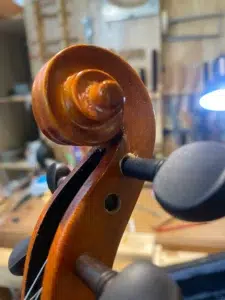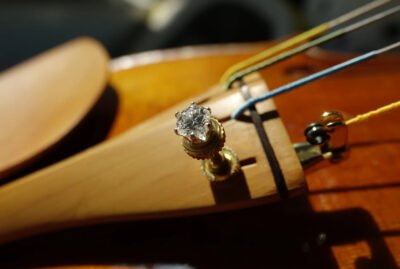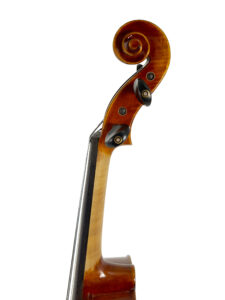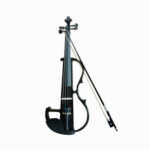Tuning the violin is an essential step to ensure that it produces its best sound. In this article, we will delve into the importance of violin tuning, the construction and tonal qualities of the violin, pitch and intonation, tuning methods and tools, as well as common tuning issues and solutions.
The Importance of Violin Tuning
Violin tuning is the process of ensuring that the violin produces the correct pitch. Whether for solo or ensemble performance, intonation is crucial as it affects the harmony and overall impact of the music. A violin with accurate pitch can harmonize with other instruments, elevating the performance to a higher and more harmonious level. Violins are sensitive to environmental factors, and changes in temperature and humidity can affect the tension of the strings, thus influencing pitch. Therefore, regular tuning greatly aids in maintaining the intonation of the violin.

Construction and Tonality of the Violin
The violin consists of various parts, including the body, neck, scroll, and tailpiece. The materials used in different parts and the construction of the instrument can impact the tonal qualities of the violin. The shape of the resonating body, the length and curvature of the neck, all contribute to the unique tonal characteristics of the violin. Tuning is not just about adjusting pitch; it also involves fine-tuning the tonal qualities.
Pitch and Intonation
The violin is traditionally tuned to the standard pitches of G-D-A-E, with the individual strings having pitches of G3, D4, A4, and E5, respectively. This standard tuning is commonly used in ensemble playing to ensure consistent pitch across different instruments, resulting in a harmonious performance. During the tuning process, a piano, tuning fork, or other reference sources are often used to match the pitch of the strings with the target notes.
What Is a Perfect Fifth?
How does the concept of a perfect fifth relate to tuning? All four strings of the violin are tuned to perfect fifths. A perfect fifth (abbreviated as P5) is the interval between two notes in a musical scale, specifically the fifth note when moving from the first note. Listen carefully to the pitch difference between each note in a P5: G D A E. This understanding can help you achieve more precise tuning.
Why Is Violin Tuning So Challenging
Tuning the violin can be a challenging aspect of learning and playing the instrument. Why is it so challenging?
String Sensitivity: Violin strings are highly sensitive, and even small adjustments can result in pitch changes. This sensitivity makes tuning more challenging, requiring players to make careful micro-adjustments to avoid inaccurate pitch. Musicians must have a keen sense of intonation and be able to discern subtle pitch variations.
String Changes: Violin strings are affected by environmental factors like temperature and humidity and can undergo changes. In unstable climate conditions, string tension may vary, causing pitch discrepancies. This necessitates frequent tuning to adapt to different environmental conditions.
Complexity of Tuning Devices: Tuners are common tools for violin tuning, but they can be confusing for beginners. Tuners often come with digital displays or LED indicators, and different models may have varying operation methods and accuracy levels. Beginners may require some time to learn how to use tuners effectively.
When Should I Tune My Violin
For beginners, the timing of tuning is crucial to maintaining the violin's intonation and sound quality. Here are some guidelines to help you determine when to tune your violin:
Before every performance: It is best practice to tune your violin before every performance. Even if you believe the pitch was accurate in the previous tuning, changes in temperature, humidity, and frequency of use can lead to minor alterations in string tension.
After temperature and humidity changes: Violins are highly sensitive to environmental changes. Fluctuations in temperature and humidity can cause the wood to expand or contract, affecting string tension and pitch. If you move your violin from a significantly colder or warmer place or experience seasonal climate changes, such as in winter and summer, you may need to retune to adapt to the new environment.
After changing strings: Tuning is necessary when you replace violin strings. New strings typically require some playing time to stabilize, so frequent tuning may be required after string changes.
After prolonged non-use: If you haven't used your violin for an extended period, such as several days or longer, the string tension may change. It is advisable to tune the violin before resuming playing.
Tuning is a key step in maintaining the intonation and sound quality of the violin. Whether before a performance, after environmental changes, string replacement, or a period of non-use, you should tune your violin. Through regular tuning practice, you will gradually improve your tuning skills, ensuring that your violin consistently produces its best sound.
Recommended APP and websites for online violin tuning:
"Violinonline" Online tuning
"ViolinOnline": Access the violin tuning feature on "ViolinOnline" where you can use the tuning pegs. Slowly turn the tuning pegs in the direction that rotates them towards the top of the violin scroll to raise the pitch of the strings. Turning them in the opposite direction will lower the pitch. Be careful not to turn the pegs too much as it may cause the strings to break. Note: It is important to use the fine tuners in conjunction with the tuning pegs for fine adjustments on the higher strings.
"Simply tuner" App
Download "Simply Tuner" violin tuning app. Recommended frequency: 442. Tune the strings until the indicator shows the centerline at "0" for successful tuning.
Tuning Methods and Tools
Violin tuning can be achieved through various methods and tools. Here are common tuning methods and tools:

Tuning with Tuners:
Tuners are widely used tools for tuning, especially for beginners. Tuners typically feature digital displays or LED lights that intuitively show the accuracy of string pitch. Musicians simply play and pluck the strings, observe the tuner's display, and then make micro-adjustments to the string tension to match the target pitch. Tuners offer speed and convenience, suitable for various environments and performance situations.
Peg Tuning:
Pegs are essential components that connect the neck and the instrument's body. Tuning with pegs involves a certain level of skill and experience, as players gently rotate the pegs to make fine adjustments to the pitch.

Fine Tuners:
Fine tuners are often mounted on the tailpiece of the violin, allowing for precise pitch adjustments. They are particularly effective when the strings are already close to the desired pitch. By rotating the knobs on the fine tuners, players can achieve accurate pitch adjustments for ideal intonation.

Bow Tuning:
Experienced players may use the bow to tune, providing a more accurate method. By bowing the strings, musicians can hear the resonance and vibrations of the strings, enabling them to sensitively judge pitch accuracy. Bow tuning requires higher skill and ear sensitivity, but it helps achieve higher tuning precision.
Does It Matter Which String I Tune First
Violinists typically start by tuning the A string to A-440 pitch and then tune the other strings to the A string's perfect fifths. If you are playing in an orchestra, the oboe often plays an A to assist orchestra members in tuning because of its pure and distinct tone. Even when using digital tuners to tune each note, careful listening is essential during the tuning process.
FAQ

During the tuning process, you may encounter common issues such as strings being too tight or too loose or strings losing their pitch. Here are some methods to address these problems:
- Fine Tuner Adjustments: Fine tuners provide a quick and convenient way to make small adjustments to the string tension, thereby tuning the pitch.
- Peg Adjustments: If you notice that the string pitch deviates from the target, try adjusting the peg's position to change the string tension.
- Proceed with Caution: During tuning, players should handle adjustments with care to avoid strings becoming overly tight or too loose. Overly tight strings are prone to breaking, while too loose strings affect intonation and sound quality. When adjusting string tension, gradual and careful micro-adjustments are necessary, gradually approaching the target pitch.
- Maintenance: Tuning involves more than adjusting pitch; it also relates to instrument maintenance. Regularly check the condition of the pegs, fine tuners, and tuners to ensure they are functioning properly. Additionally, keeping the strings clean and replacing them is a significant factor in maintaining intonation.
- Improve Tuning Skills: Tuning is a skill that requires continuous practice and improvement. Beginners may need several attempts to accurately tune the strings, but with accumulated experience, tuning becomes easier and more precise. Musicians can enhance their tuning skills by practicing and trying different tuning methods.
Conclusion
Violin tuning is a crucial step in ensuring harmonious musical performance. By adjusting the tension of the strings to match the target pitch, musicians can bring out the best sound quality of the violin. Whether using tuners, fine tuners, or bow tuning, continuous practice and refinement are necessary to achieve accurate pitch and beautiful tonality. Tuning not only enhances the musical aesthetics but also reflects the player's skill and understanding of music. Violin tuning is a fundamental skill for every violinist."






